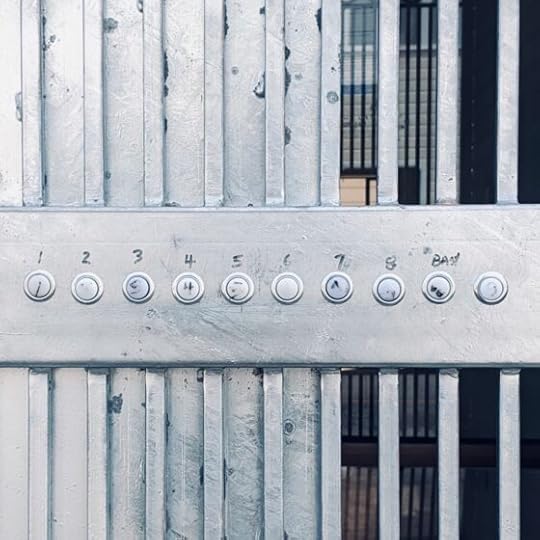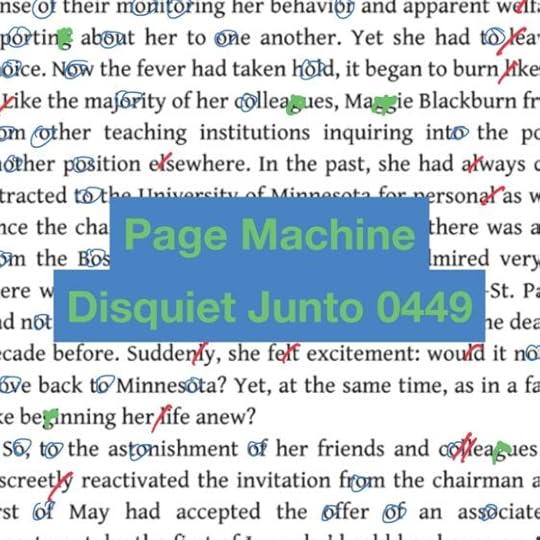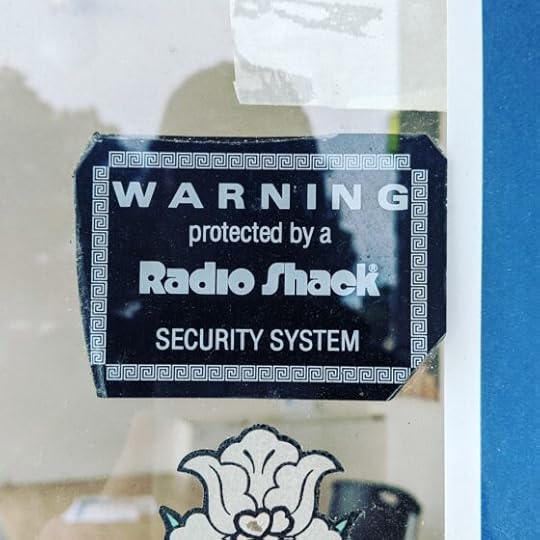Marc Weidenbaum's Blog, page 225
August 11, 2020
Loraine James’ Fluid Techno Refactoring
Ten-plus minutes into this bracing live techno set by Loraine James, posted as a video by Fact Magazine today, I thought to myself, “She’s still playing ‘Glitch Bitch.'”
I wasn’t complaining, not by any means. Quite the contrary, it was great to have the opportunity to stretch out and luxuriate in the light breakages, the fluid refactoring, that she brings to the music in extended form. A friend then mentioned to me that James, on Twitter, had herself expressed surprise: “didnt realise I played ‘Glitch Bitch’ for 13 minutes..oops.” The original version of the song clocks in at a mere 3:12 on the album For You and I, where it’s the lead track. In the video, it’s more than a third of the set’s nearly 33-minute runtime.
I’ve never known quite what to make of the snippet that serves as the song’s title and lyric — less a lyric than a prominent sample reworked this way and that for the full length of the piece. It may mean be intended as something else entirely, but I’ve taken the song to be an act of James grabbing hold of a dismissive statement and turning it inside out, pushing back by making it her own, so thoroughly owning the phrase that it becomes a powerful symbol of transformation and expertise. That’s certainly the case with the underlying beat, how James lets unfurl and then pulls back gleaming rhythmic patterns, coaxing odd meters and pulse-disorienting pauses as she goes.
Video originally posted at YouTube. More from James at lorainejames.bandcamp.com.
August 10, 2020
Forest Synth
Me, I’m too nervous with what little gear I have to take it out of the house, let along to lug it into the forest. Then again, I’m a city mouse, and camping isn’t my thing. In this gorgeous footage, shot in Japan, a modular synthesizer takes root among trees, dappled by the light as filtered through leaves. Part of the beauty of it is not knowing where the synthesis ends and the songs of birds and insects begin. The source YouTube account, named Wac- Lounge, has only been up since May of this year, yet has already racked up over two dozen modular-synth videos worth checking out, some indoors, some out.
Video originally posted at youtube.com.
August 9, 2020
Current Listens: Sampled Sources, Roadside Tuba
This is my weekly(ish) answer to the question “What have you been listening to lately?” It’s lightly annotated because I don’t like re-posting material without providing some context. In the interest of conversation, let me know what you’re listening to in the comments below. Just please don’t promote your own work (or that of your label/client). This isn’t the right venue. (Just use email.)
▰ ▰ ▰ ▰ ▰ ▰ ▰ ▰ ▰ ▰ ▰ ▰ ▰ ▰ ▰
NEW: Recent(ish) arrivals and pre-releases
▰ Warp & Weft is a lovely, free, six-track release posted by Scanner (based in London) of delicately reworked samples from kalimba alongside soft synth lines, lightly glitched and filtered. The first two tracks (“Wefte,” “Wevan”) and sixth (“Weave into Time”) are especially sedate and gentle. The album was recorded live and released this past Friday, August 7.
▰ The free Reel Feels (Sound Pack), by Frankfurt-based musician Jogging House, is the source audio from which Scanner derived his Warp & Weft album, but you don’t need to be a musician to take advantage of it. The first five tracks are beautifully torqued recordings of kalimba (or mbira), turned into pure atmosphere, each a minute or longer. Put them in a playlist and set them to loop on random. You’ll lose track of time happily.
Reel Feels (Sound Pack) by Jogging House
▰ Sometimes an instrument is just as useful on the receiving end of sound, such as this great ongoing series in which a tuba amplifies nearby audio, here rendering deep metallic reverberations from passing traffic.
A Place, a Space
Apropos nothing in particular except that it’s Sunday and I’m writing up some recent favorite listens to post at disquiet.com, and I wanted to mention how my website/blog is one of the key things keeping me sane during this pandemic (others: family time, exercise, guitar and synth learning, offline journal, long-term writing projects). Having a place to write a bit, to reflect on things, to share in a not-engineered-toward-feedback and yet open-to-reply space is a good space to have. Metaphorically, it’s more like keeping the garage door open while fiddling at the workbench than like, say, hanging in a public park. I’ve managed, for the first time in the blog’s (nearly) 24 years of existence, to write at least once every day this year, sometimes a short thing, sometimes something more substantial. In addition, more than ever, I’ve found myself just pulling up the website in a browser tab in the middle of the day to take look, as one might open a window to the backyard or pick up a family photo. Flip back a few days, see what’s been on my mind, sometimes to plot what to write next, but mostly just to spent time in a place where I enjoy spending time.
The above was something I initially, earlier this afternoon, mentioned in a thread about blogging at llllllll.co (aka Lines), the main public online community where I hang out. Then I figured I’d note the thoughts here, too.
August 8, 2020
Fuzzy Sigil

While not quite the Fibonacci sequence, these 10 buttons at the entrance to an apartment building do make the visitor wonder what’s next. In fact, you’re left wondering before the sequence is even over. There are 8 buttons, numbered as such, and then what can be deciphered as “basement” (“BAST”? Why not “BSMT”?) and then … then it gets odd. There are twin rows of information to go by: the legible digits scrawled on the gate surface with a magic marker, and the almost-rubbed-off ones on the buttons themselves (apartment 6 seems to have been quite popular, judging by the wear; 4 not so much). Which leaves the fuzzy sigil on the 10th button noticeably uncertain. It looks like a 9, but why does it come after the basement and not before? What logic explains this ordering? And come to think of it, prior to “BAST” having been written above the basement button, what exactly was inked on the button itself? Gotta love a good mystery, especially a makeshift one.
August 7, 2020
375 Neighborhoods in All Their Sonic Glory

NYC Sounds Covid-19 is exactly what it sounds like, so to speak: “A collection of field recordings made in every single neighborhood in NYC documenting the quieter city while under quarantine due to the COVID-19 pandemic.” It’s the work of Geoff Gersh, who has wandered the city in recent months, recording throughout the five boroughs, some 375 neighborhoods by his count, everywhere from Co-Op City in the Bronx (bird song, the river-like whoosh of traffic) to Canarsie in Brooklyn (church bells and street chatter) to Washington Square Park in Manhattan (cheering) to South Ozone Park in Queens (music from a radio, a car starting) to Howland Hook in Staten Island (car alarm, the raspy engine of a passing plane, or maybe it’s a scooter of some sort). It’s a remarkable collection, massive in scale, and both comfortingly repetitive and filled with distinct moments. Gersh captures the spaces with incredible detail and a rich sense of place. Put on some headphones, sit still, and listen as cars and birds alike pass through the stereo spectrum. Then listen deeper into the atmosphere of the city, one neighborhood at a time.
According to a brief bio, Gersh performs (presumably pre-Covid) music to silent films at the Nitehawk Cinema in Williamsburg, Brooklyn, as part of the bands Black Lodge and Reel Orchestrette, and has released three CD on, appropriately, the label Deep Listening, founded by the late, great Pauline Oliveros.
Get the full set (name your price) at nycsoundscovid19.com.
August 6, 2020
Disquiet Junto Project 0449: Page Machine

Each Thursday in the Disquiet Junto group, a new compositional challenge is set before the group’s members, who then have just over four days to upload a track in response to the assignment. Membership in the Junto is open: just join and participate. (A SoundCloud account is helpful but not required.) There’s no pressure to do every project. It’s weekly so that you know it’s there, every Thursday through Monday, when you have the time.
Deadline: This project’s deadline is Monday, August 10, 2020, at 11:59pm (that is, just before midnight) wherever you are. It was posted on Thursday, August 6, 2020.
These are the instructions that went out to the group’s email list (at tinyletter.com/disquiet-junto):
Disquiet Junto Project 0449: Page Machine
The Assignment: Read a page of text from a book as if it were a musical score.
Step 1: You’ll be reading, so to speak, a page of text from a book as if it were musical score. Select such a page from such a book, perhaps that has special meaning to you, or perhaps at random.
Step 2: Make a copy of this page, or be prepared to write on it directly.
Step 3: Study the page, less as a work of writing, and more as a two-dimensional sculpture. Take note of the shapes inherent in the text. Are there a lot of paragraph breaks? Are there snakelike descending curves where spaces occur between words? Are there a lot of o’s. Or periods. Or question marks? Find some patterning that is of interest.
Step 4: Make a set of rules for yourself as to what these symbols mean. Is every paragraph break a beat? Is every capital I a stately chord? Is every apostrophe a cowbell?
Step 5: Record a piece of music based on applying the rules in Step 4 to the page selected in Step 1.
Seven More Important Steps When Your Track Is Done:
Step 1: Include “disquiet0449” (no spaces or quotation marks) in the name of your tracks.
Step 2: If your audio-hosting platform allows for tags, be sure to also include the project tag “disquiet0449” (no spaces or quotation marks). If you’re posting on SoundCloud in particular, this is essential to subsequent location of tracks for the creation of a project playlist.
Step 3: Upload your tracks. It is helpful but not essential that you use SoundCloud to host your tracks.
Step 4: Post your tracks in the following discussion thread at llllllll.co:
https://llllllll.co/t/disquiet-junto-project-0449-page-machine/
Step 5: Annotate your tracks with a brief explanation of your approach and process.
Step 6: If posting on social media, please consider using the hashtag #disquietjunto so fellow participants are more likely to locate your communication.
Step 7: Then listen to and comment on tracks uploaded by your fellow Disquiet Junto participants.
Additional Details:
Deadline: This project’s deadline is Monday, August 10, 2020, at 11:59pm (that is, just before midnight) wherever you are. It was posted on Thursday, August 6, 2020.
Length: The length is up to you. Remember: it’s a page, not a novel.
Title/Tag: When posting your tracks, please include “disquiet0449” in the title of the tracks, and where applicable (on SoundCloud, for example) as a tag.
Upload: When participating in this project, be sure to include a description of your process in planning, composing, and recording it. This description is an essential element of the communicative process inherent in the Disquiet Junto. Photos, video, and lists of equipment are always appreciated.
Download: It is always best to set your track as downloadable and allowing for attributed remixing (i.e., a Creative Commons license permitting non-commercial sharing with attribution, allowing for derivatives).
For context, when posting the track online, please be sure to include this following information:
More on this 449th weekly Disquiet Junto project, Page Machine (Read a page of text from a book as if it were a musical score), at:
More on the Disquiet Junto at:
Subscribe to project announcements here:
https://tinyletter.com/disquiet-junto/
Project discussion takes place on llllllll.co:
https://llllllll.co/t/disquiet-junto-project-0449-page-machine/
There’s also a Disquiet Junto Slack. Send your email address to twitter.com/disquiet for Slack inclusion.
August 5, 2020
Drum Machine Ruler
If you’ve ever plucked a metal ruler or banged it on the edge of a table, you know the vibrant, heady pulse of its taut rebound. The talented Moscow-based engineer Dmitry Morozov, who goes by ::vtol::, recognized the promise in that boinngggg and automated it. The result, a combination of processing power, two servo motors, and other items, is a programmable drum machine that makes all its sounds with a 20-centimeter metal ruler. This demo video shares some of its sonic and rhythmic potential.
Writes Morozov:
The device is based on the school experience of imitating bass lines at the desk and a fun way to disturb teachers. The instrument can be classified as an automated plucked contrabass monochord. Changing the pitch is done by quickly changing how far the ruler is extended relative to the nut. Movements, plucks and presses of the ruler along the nut are driven by powerful and fast motors, which allows playing pretty fast lines. 2 pressing motors can work simultaneously or selectively, which allows you to choose the register: the range and amplitude of oscillations depends on the place in which the ruler is clamped before the pluck. The sound is picked up by a small piezo element, which is getting hits by a ruler directly (the instrument has no resonator). The instrument is equipped with 12 touch keys, each of which can be reassigned to a specific length of the ruler. A small OLED display is used to select modes, tune notes, and indicate processes and states.
The device is called the RBS-20(cm), which stands for “Ruler bass synth, 20 centimeters.” Video originally posted at vimeo.com. More details at vtol.cc.
August 4, 2020
Retro Surveillance Theater

Security, or “Come right in and make yourself at home”?




